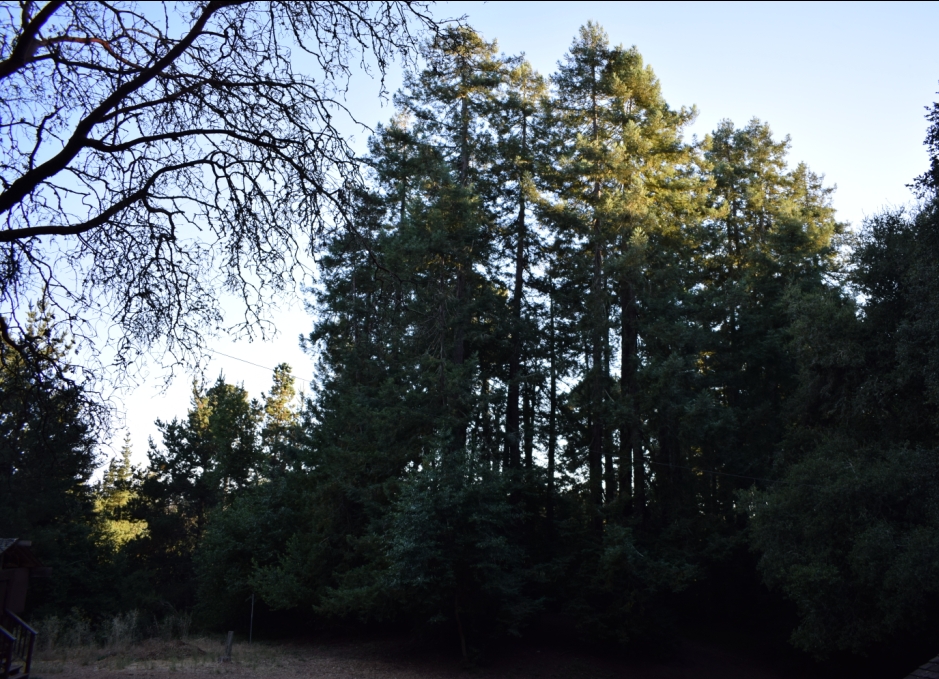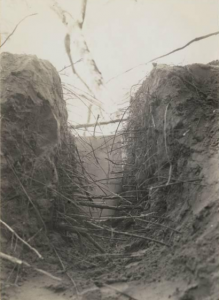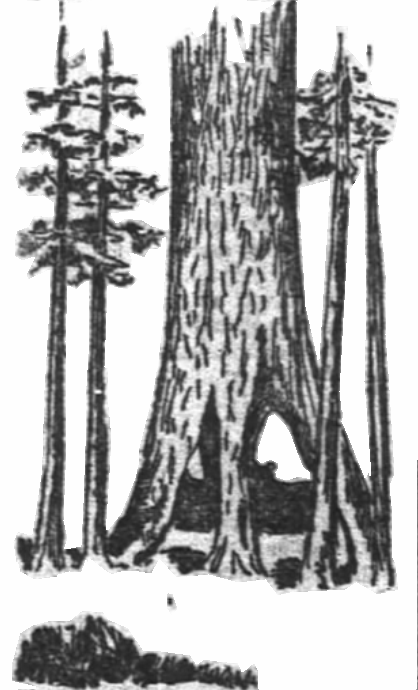Santa Cruz Big Trees
Peculiarities of Their Growth.
SPRINGING FROM OLD TRUNKS
The Present Giants of the Forest Descendants of Greater Progenitors
San Francisco Chronicle – Sunday, June 9, 1889 – Page 2
While wandering through the Big Tree grove near Santa Cruz admiring their gigantic size and fine proportions, one cannot fail to notice that those trees (the sequoia sempervirens— those in the Mariposa grove being Sequoia gigantea) grow in groups, with here and there fine solitary specimens.
Redwood Fairy Rings

This 1889 anonymous piece is one of, if not the first public presentation about Fairy Rings. It documents a very large ring that includes the General John Fremont tree in the Henry Cowell State Park near Santa Cruz California.
Just as the size of the Coastal Redwoods was so large that the general public thought the initial claims to be a hoax, so too are the even larger fairy rings that suggest trees that in this case are over 60 feet in diameter. The answer for how such a giant ring might be possible could be found with Dr. William Gibbons documentation of a fairy ring in Oakland where a coalescence of three separate redwoods grew together so closely as to create a 57 foot ring, The Fremont tree ring for which it is a modest, but still very large part of, could also be another example of a coalescence of very large trees. But, unlike the Oakland situation, there is only the fairy ring itself as evidence, that still leaves the question open on whether there were even larger, more ancient super Redwoods of the past.
This particular website documents currently living trees and their sizes. But doesn’t speculate about the monumental size of dead redwood trees, suggested by their fairy rings, as this 1889 pieces delves into.
Information about such giant trees is generally disputed, with claims that larger trees would collapse under their own weight. Unless, that is, they did exist and claims/theories for how they couldn’t be possible would then have to be put aside. Do a Google search on “Redwood Fairy Rings” and look at the images option to see other rings.
Below is a 60′ fairy ring located just below Redwood Peak in the Oakland Hills. Its location nearly matches the description made by Dr. William Gibbons of the 57 foot coalescence ring, but in this case may be an even larger ring, as there is no confirmed documentation of exactly where the Gibbons tree was located.
Information about such giant trees is currently blocked, with claims that larger trees would collapse under their own weight. Unless, that is, these larger trees had a different climate to contend with, that kept its internal water levels high. Below is a 60′ fairy ring located just below Redwood Peak in the Oakland Hills. Its location matches the description made by Dr. William Gibbons of a 57′ ring that once was three redwoods that grew together to form a giant base.
As presented in the history of the Oakland Redwoods, this area was heavily attacked by Yankee lumberjacks immediately following the 1849 Gold Rush. All the big trees were cut down within 5 years, with even the stumps dug up and used for shingles or firewood. Some surviving stumps sprouted 2nd generation saplings that started to mature after the area was abandoned by organized mill operations.
However, most of the second growth trees were again cut down following the 1906 earthquake, when San Francisco was rebuilt. This area originally known as the San Antonio Redwood Grove, after the son of Luis Peralta who owned Rancho San Antonio (Oakland). The grove was purchased by the city of Oakland, following the successful August 29, 1922 bond election and was broken into two separate city parks (Joaquin Miller & Roberts Recreation Area) that are divided by Skyline Blvd, the old logging road used to haul out the original first growth trees. The two parks are now part of the East Bay Regional Park System.
One of the most amazing experiences is to stand on any of the Fairy Ring mounds. There are only a few locations in the Oakland hills where the extremely large redwood root mounds can be found. In one case, the mound is over 10 feet high and well over 100 feet in diameter. Since this location was hit repeatedly axe-men even the 2nd and 3rd generation fairy rings were removed. As each new tree is technically a clone of the original, hopefully someday we will know more about the ancient story hidden in the mounds.
Upon a closer examination these groups are found to be made up of a number of trees standing upon the periphery of a circle of greater or less diameter, and it is not difficult to trace between the two the remains of stumpage connecting one with the other around the whole circumference. Finally it is apparent that the magnificent trunks now standing have sprung from the outer edge of still greater trees, whose enormous bulk once filled the circle enclosed by the present growth. A number of these groups have been carefully measured and the result is interesting.
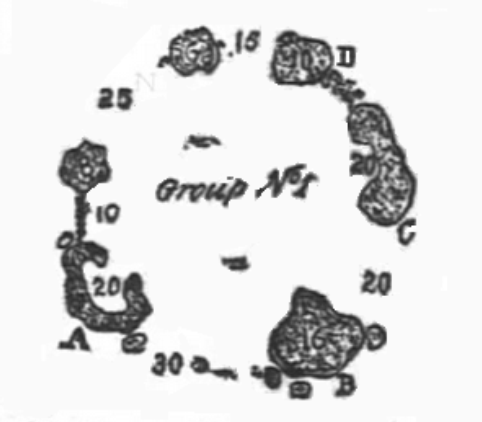 The figures within the trunk plans indicate the diameters of the trees standing as shown in a circle, while the distances from one to the other are given by the figures between. It will be seen that group 1 has a circumference of about 190 feet, which means a diameter of sixty-three feet. “A” is called General Fremont It is hollow and in 1845 the great “Path-finder” had his headquarters in it. Connecting this one and “ B” (named “Jumbo”) there are traces of the stump of the parent tree, from which this circle of trees has sprung. “C” is a “twin”’ tree and with “D” are called the “Three Sisters.” They are connected by a line of stumpage, and trees of this are found around the rest of the circumference. Within the circle are also remains of the parent tree.
The figures within the trunk plans indicate the diameters of the trees standing as shown in a circle, while the distances from one to the other are given by the figures between. It will be seen that group 1 has a circumference of about 190 feet, which means a diameter of sixty-three feet. “A” is called General Fremont It is hollow and in 1845 the great “Path-finder” had his headquarters in it. Connecting this one and “ B” (named “Jumbo”) there are traces of the stump of the parent tree, from which this circle of trees has sprung. “C” is a “twin”’ tree and with “D” are called the “Three Sisters.” They are connected by a line of stumpage, and trees of this are found around the rest of the circumference. Within the circle are also remains of the parent tree.
Oakland Fairy Rings
Introduction
Fairy Rings, as suggested in this 1889 article represent more than just a shadow of a former giant or not so giant redwood tree, but of a place where an immortal being lives. These creatures have been chopped down and then abandoned as beings that should be explored, for they represent one of the most perfect lifeforms that has ever evolved on Earth. Scientists speak of this species as having survived along the California coast for millions of years. And without skipping a beat, acknowledge that it has a nearly unique ability to clone itself.
The two Santa Cruz examples clearly took the unknown author (F.L.C.) a good amount of time to investigate and document. Its unknown what other work he may have done and whether or not it was critiqued in any manner. For now, it can be assumed that scientific work in this area was shifted to – how can we perfect our skills at killing the tree, and later how to crop the redwoods like wheat or corn, rather than looking deeper into the mystery of its root system and life.
Since this is merely conjecture without hard science and its tools, the rest of this presentation will be about exploring a number of the fairy rings in the Oakland hills. Certainly more to come on this project.
The core question: Is there a way to identify the age of root fibers? Or is this a wasted focus, as the fibers themselves are replaced by new ones that, like the top of the tree grow and die over time, except for the the larger roots? More core questions to come.
As noted in a previous piece, one website/author has suggested that redwoods are actually limited in how large they can grow based on their own size and weight. This statement never discussed the relevance of these massive fairy rings and the claims that substantially larger trees may have existed in the past.
Background
A few years before his death, William P Gibbons wrote a piece that was published in a short lived UC Berkeley Botany journal, Erythia. In it, he spoke about two tree rings, the largest being a 57 foot across fairy ring that had been created when three redwood trees grew together at the base. There are currently two candidate sites up on Redwood Peak for where this may have been. The hope here, is to do a similar map of both of these places to start. Note that in the first inset on this piece titled “Redwood Fairy Rings” there is a picture of the ring I believe is the actual site at the bottom. As time permits, more materials will be posted in this drop down section as they are produced.
Not far from this group stands the “Giant.” It is a solitary specimen, and is one of the few very large trees in this grove that is not hollow at the base. Its circumference is sixty feet and height 300.
Almost all the large trees are surrounded by a circle of smaller ones. This to finely shown in group 2, of which a plan is given:
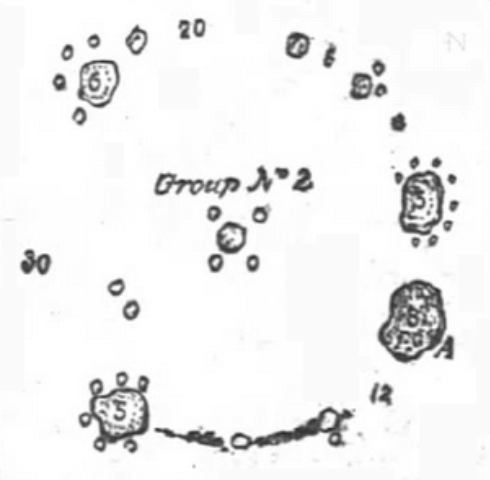 In this group the largest tree is A, called “General Castro,” that has a diameter of eight feet. Clustered about almost every large tree in this group are smaller ones, while between the circumferential trees there are the decayed remains of the parent tree. Estimating the probable height of these central trees by the dimensions of those now standing, It may be conjectured that the parent group rose to the height of at least 500 feet.
In this group the largest tree is A, called “General Castro,” that has a diameter of eight feet. Clustered about almost every large tree in this group are smaller ones, while between the circumferential trees there are the decayed remains of the parent tree. Estimating the probable height of these central trees by the dimensions of those now standing, It may be conjectured that the parent group rose to the height of at least 500 feet.
In group 2 will be noticed a repetition of the “twin” growth of those trees “s” own in No. 1. There two of the “ sisters” have the same outline as the “General Castro,” and this “twinning” is not an uncommon occurrence in the grove.
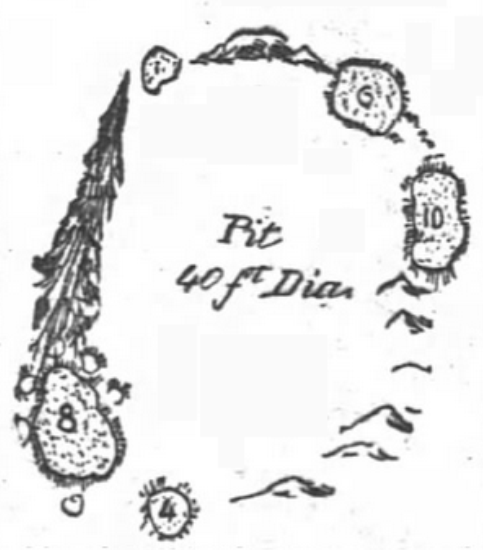 The above sketch gives an example of a group in which the shell of the parent tree to yet standing. In this, as well as in some other instances observed, fragments of the old tree stand in such relation to each other as to indicate a diameter of thirty or forty feet. The sketch to partly In plain and partly in elevation, the attempt having been made to more clearly indicate the “shell” of the old tree than would have been possible otherwise.
The above sketch gives an example of a group in which the shell of the parent tree to yet standing. In this, as well as in some other instances observed, fragments of the old tree stand in such relation to each other as to indicate a diameter of thirty or forty feet. The sketch to partly In plain and partly in elevation, the attempt having been made to more clearly indicate the “shell” of the old tree than would have been possible otherwise.
The “pit,” so called at the time the measurements were made, was full of water. On the margin of the pit there stand trees eight and ten feet in diameter, well defined fragments of the shall of the original tree, and encircling groups of still smaller trees which, though of the third generation, are still 100 or 150 feet in height.
In sketch 4 there is shown a type of tree of the second growth surrounded by its colony of third-growth trees. It will be seen that the parent tree is hollowed out extensively at the base, partly by fire, partly by natural decay. The burning out has been done no doubt year after year as often as the fires lit by the Indians in former years, now started through the carelessness of hunters, lumbermen and others, annually devastate the forests. When such fires sweep over a region clothed with the pines, Junipers and other trees rich in turpentine and resin, their destruction follows, and no young trees spring up to take their places. But in the redwood groves such fires have but little effect upon the vitality the sequoias. That family of trees has no inflammable juices. and their unusually thick bark using spongy, and the wood itself holding a large quantity of water, the trees are practically fireproof.
A large proportion of these trees when felled are found to be decayed In the center. Their vitality seems to lie in the young wood next to the bark, and so concentrated is this life principle at that point that stumps of trees cut down forty years ago still show signs of life in the production of new wood next to the bark.
It is calculated that there is as much of the redwood tree under ground as there to above. When road cuttings have been made on the margin of redwood groves the roots of the trees have been uncovered a hundred feet distant from the trees themselves. It follows, therefore, that “redwood lands” cannot be cultivated for many years. Once cleared, the land affords quite good pasturage, but around each stump there grows a thick fringe of young trees.
Any estimate of the age of the redwoods based upon the “rings” of growth is purely conjectural It is not safe to attribute one “ring” to each year; but in any case the older trees must antedate the commencement of the Christian era.
It is very pleasant beneath those majestic monuments of a bygone age. Sitting beneath their shade we see the sunlight glancing through the open spaces between the massive reddish-brown shatts, and lighting up the feathery foliage with a brilliant but soft tint of green that gives warmth and brightness to the scene. There is a driveway leading up from the ford flanked on either side by the pillared trunks raising straight and still more than two hundred feet above us. Beyond this gateway is a vista of sun-lit foliage, the alder and willow filling up the middle distance, while among them glitter the smooth scented leaves of the bay.
All through the grove there reigns a stillness, broken now and then by the far-echoing whistle of an approaching train, or the more frequent sound of the wood-chopper’s ax. There is the never-ceasing sighing of the passing breezes through the tapering tree tops, and an undertone of rushing water in the stream near at hand. Here and there a bird to seen flitting about the branches, and now and then a squirrel dashes across from one great trunk to another. They skurry over the open ground at top speed, and then, when safe on their way up the massive trunks, they stop to flirt awhile with those who are watching them. A group of merry children play hide and seek about the half hollow trunks of the “ Three Sisters”; gray-haired men and women from the East wander about and crane their necks in the effort to catch a glimpse of the sky-soaring tops of the great trees. In the distance to seated a loving couple. He with his arms about her slender waist; she tracing erratic lines on the smooth sand with his cane.
It’s the old, old story, told in the centuries gone beneath these very trees—even these giants of their kind —by many an Indian lover to many a maiden of his tribe.
The generations come and go, but these great trees remain. They stood there long before man peopled this western coast; they will remain there long after we who speculate upon their growth have passed away. F. L. C.


